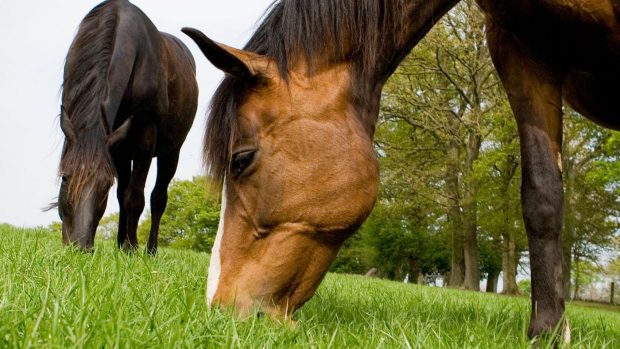In her new book Animals, Ethics and Us, vet and past president of the British Equine Veterinary Association Madeleine L.H. Campbell discusses the different ways that people use animals and the moral issues surrounding this.
In this first extract, she focuses on the use of animals in sport…
Those who argue in favour of allowing the use of animals (racehorses in particular) in competitive sport sometimes argue that the animal has been deliberately bred over generations for a very specific purpose, and that to abolish competitive sport would be to remove the need for such purpose-bred animals to exist. Supporters of competitive animal sport argue that it is better that such animals should exist, even with the acknowledged risks of competing, than never exist at all.
That argument is not, in my view, sufficient in itself to allow the continuation of animal sport. First, welfare issues in competition animals occur not only during their competition years (when they are generally well looked after), but before and after that period of their lives. All of the welfare issues that can occur across an animal’s lifespan, not just during its competition years, must be taken into account when weighing up whether the animal has derived an overall benefit from existing. Second, if one accepts that animals (unlike most humans) have no abstracted view of the value of their life, or about their future, then whether or not an animal has “a life worth living” is related only to the physical or mental pleasure or pain the animal experiences, either at a specific moment in time, or as an accumulation of those moments.
In human medicine, arguments about “lives worth living” often relate to the impact of disability or illness, particularly if the disability/illness is painful. Of course, each person’s opinion about whether their own life is worth living is unique, but in general there is an acceptance that whether or not a human life is worth living depends not simply on the severity or absence of a disability/illness, but also on other factors such as intellectual enjoyment, pleasure in relationship friends and family, and so on.
Animals do seem to take pleasure in interactions with other animals, many of which (eg dogs playing or horses mutually grooming) form an inherent part of their normal behaviours. But it is nonetheless hard to imagine that, faced with a painful or recurrent welfare insult, an animal has the capacity to rationalize tolerating that insult on the grounds that any suffering is outweighed by positive social interactions or future enjoyments. It follows that there must be a number, severity or duration of welfare insults to an animal beyond which its life, as an animal experiences that in an immediate way, is not worth living. Therefore it is not, in my view, necessarily always true that it is better for a racehorse, for example, to have lived than never to have lived at all, and consequently arguments that animal sport should be allowed to continue because it is better for the animals involved to have lived than never to have lived are flawed.
Should the use of animals in competitive sport be banned?
One could make a harm:benefit ethical argument that since welfare problems undeniably occur, and since there is no inherent benefit to the animals concerned in competing, the use of animals is competitive sport is simply not ethical, and should be banned. This is an argument espoused by the organizations that campaign for an end, for example, to greyhound or horseracing. However, it is an oversimplification. It is certainly true that benefits a successful human athlete experiences as a result of competing — such as fame or wealth — are not directly applicable to an animal athlete. However, it is probably also true (not withstanding the need to adapt management methods to allow expression of normal behaviours) that successful equine and canine athletes are generally treated very well by their owners and trainers. This applies at least during the animals’ competition careers, if only because treating them well maximizes the chance of financial success. Unsuccessful animal athletes are generally more likely to suffer chronic welfare problems than successful ones. Thus one could argue that, at least part of its lifetime, it benefits an athletic animal to be involved (successfully) in competitive sport.
One argument that is often offered as a reason to ban competitive animal sport is that the animal athlete, unlike a human athlete, has no choice about whether they compete (and adopt the attendant risks of injury) or not. Although an animal athlete sometimes apparently ‘refuses’ to compete — for example, if a horse refuses a jump, or a greyhound fails to start running when the trap doors are opened — as a generalization most animal athletes, very nobly, at least try to do what humans ask of them.
Certainly, animals do not have any choice about their involvement in competitive sport. However, it is not really true that human athletes do have an uncomplicated choice about whether they compete or not. A footballer on a short, fixed-term contract, for example, may feel obliged to compete whilst injured if his contract renewal date is near, the management want him to compete, and he has a family dependent on his income, even if he knows that it is not in the best interests of his long-term health to do so. Similarly, in the American system of selection for the Olympic track and field team, where everything is decided on the results of one competition, athletes may face a choice of competing whilst injured or foregoing the central ambition of their career.
In human medicine, the conscious desire of athletes to train or compete whilst injured presents the doctors responsible for their care with an ethical dilemma. Should such doctors acquiesce in providing ‘patch up’ treatment (eg intra-articular anti-inflammatory medication), or should the doctor withhold treatment on the grounds that the most appropriate treatment in terms of resolving the injury and safeguarding the athlete’s long-term health is enforced rest? There is considerable discussion of such ethical issues in the literature on human sports medicine, which emphasizes not only the athlete’s autonomous right to decide his/her own course of treatment, but also the potential conflict of interests that can arise when a doctor is employed by a sports team or organization rather than by an individual athlete. In such a situation, the doctor may be torn between a responsibility for the athlete’s health and a responsibility to the team to ensure that the chosen athletes are available for selection, particularly if the athlete is insisting that he/she wishes to compete.
This situation is not dissimilar to the situation that arises for veterinarians dealing with competition animals. Though the rules about how an animal can be treated within competition are clear, much less regulation pertains to how an animal may be treated between competitions. The veterinarian has to deal not only with the patient (who in this case is incapable of expressing an opinion about whether they should be treated or rest), but also with a group of people that may include a trainer, an owner, and, in the case of horses, a rider/jockey, any of whom may be paying the vet (depending on the arrangements), and each of whom may hold differing views from the other. Matters can be further complicated if the veterinarian is employed as an assistant by a senior veterinarian/partner who has strong views on the course of action that ought to be followed.
The primary duty of the veterinarian — to the welfare of the animal — is clear in both regulatory and moral terms. Where conflict exists between the views of an animal owner/trainer/rider and those of the veterinarian, the veterinarian has a moral responsibility to act as an advocate for the animal’s welfare. Professional Codes of Conduct, such as those of the Royal Veterinary College and those of the American College of Veterinary Medicine, can and should provide support to veterinarians facing such difficult situations. However, any ethical decision-making process is undeniably complicated by the fact that the trainer, owner, and rider, as well as the veterinarian, like the footballer in the example above, may have a family and employees to support. In a harm:benefit analysis, keeping an animal competing may benefit all of those interests, something that cannot be ignored in utilitarian ethical decision-making.
Article continues below…
You might also be interested in:

Leaving water on a horse will not make it hotter: expert busts the scraping myth

London 2012 gold medal-winner to be retired at Hickstead
’It's hard to imagine never going in the ring with him again. I love him so much and always will’

Subscribe to Horse & Hound this spring for great savings
Another argument offered as a reason to ban the use of animals in competitive sport is that such use is trivial when compared to other uses of animals, such as medical research. In other words, the welfare-challenging use of animals in sport is not ethically ‘necessary’, in the sense that the benefits to humans (in terms of entertainment, or income from bets) are trivial, and therefore insufficient to offset adequately the welfare costs to the animals involved.
Again, this argument is an oversimplification. To take equestrian sport as an example, the gross output of the non-racing equestrian sector in the UK was estimated by a 2011 report of the British Equestrian Trade Assocation to be £3.8 billion per annum. Racing contributed a further £3.45 billion to the UK economy in direct, indirect, and induced expenditure, and £275 million in tax revenues in 2012. In New Zealand, the economic impact of the horseracing industry in 2013 was equivalent to that of the wine and seafood industries. Financial benefits from equestrian sport accrue not only to owners and trainers, but also to those working in the sport or in associated industries (eg farriers, caterers, clothing suppliers), and their dependents. Equestrian sport is actually far from trivial in the economic sense, and it is also socially significant: racing was second only to football for attendance figures in the UK in 2012.
Taken along with the undoubted enjoyment many spectators derive from animal sport (which one could think of as a positive mental health effect), such data suggests that, if one is prepared to allow human interests to trump animal interests [discussed in chapter one of the book], in a harm:benefit ethical argument there are convincing reasons not to abolish the use of animals in sport completely. The ethical imperative then becomes one of maximizing the welfare of competitive animals, whilst continuing to allow their use.
Some minor edits have been made to the text where the original includes cross-references to other parts of the book or other sources.
Price: Animals, Ethics and Us can be purchased for £18.95 from 5m Publishing
Published by: 5m Publishing, 2019
For all the latest news analysis, competition reports, interviews, features and much more, don’t miss Horse & Hound magazine, on sale every Thursday.




